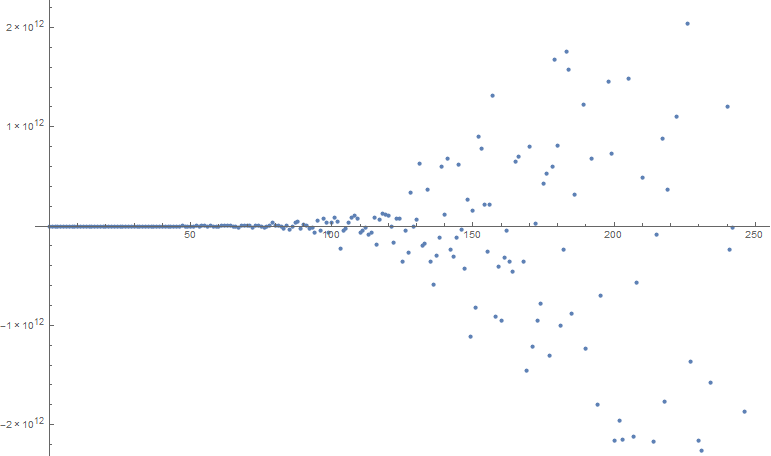Difference between revisions of "Ramanujan tau"
From specialfunctionswiki
(Created page with "The Ramanujan tau function $\tau \colon \mathbb{N} \rightarrow \mathbb{Z}$ is defined by the formulas $$\displaystyle\sum_{n=1}^{\infty} \tau(n)q^n = q \prod_{n=1}^{\infty} (1...") |
|||
| Line 2: | Line 2: | ||
$$\displaystyle\sum_{n=1}^{\infty} \tau(n)q^n = q \prod_{n=1}^{\infty} (1-q^n)^{24} = \eta(z)^{24}=\Delta(z),$$ | $$\displaystyle\sum_{n=1}^{\infty} \tau(n)q^n = q \prod_{n=1}^{\infty} (1-q^n)^{24} = \eta(z)^{24}=\Delta(z),$$ | ||
where $q=e^{2\pi i z}$ with $\mathrm{Re}(z)>0$, $\eta$ denotes the [[Dedekind eta function]], and $\Delta$ denotes the [[discriminant modular form]]. | where $q=e^{2\pi i z}$ with $\mathrm{Re}(z)>0$, $\eta$ denotes the [[Dedekind eta function]], and $\Delta$ denotes the [[discriminant modular form]]. | ||
| + | |||
| + | <div align="center"> | ||
| + | <gallery> | ||
| + | File:Ramanujantau.png|Plot of $\tau(n)$ for $n=0,1,\ldots,250$. | ||
| + | </gallery> | ||
| + | </div> | ||
| + | |||
| + | |||
=Properties= | =Properties= | ||
Revision as of 23:03, 1 April 2015
The Ramanujan tau function $\tau \colon \mathbb{N} \rightarrow \mathbb{Z}$ is defined by the formulas $$\displaystyle\sum_{n=1}^{\infty} \tau(n)q^n = q \prod_{n=1}^{\infty} (1-q^n)^{24} = \eta(z)^{24}=\Delta(z),$$ where $q=e^{2\pi i z}$ with $\mathrm{Re}(z)>0$, $\eta$ denotes the Dedekind eta function, and $\Delta$ denotes the discriminant modular form.
Properties
Theorem: $\tau(mn)=\tau(m)\tau(n)$ if $\gcd$$(m,n)=1$
Proof: █
Theorem: $\tau(p^{r+1})=\tau(p)\tau(p^r)-p^{11}\tau(p^{r-1})$ whenever $p$ is prime and $r>0$
Proof: █
Theorem: $|tau(p)| \leq 2p^{\frac{11}{2}}$ for all primes $p$
Proof: █
